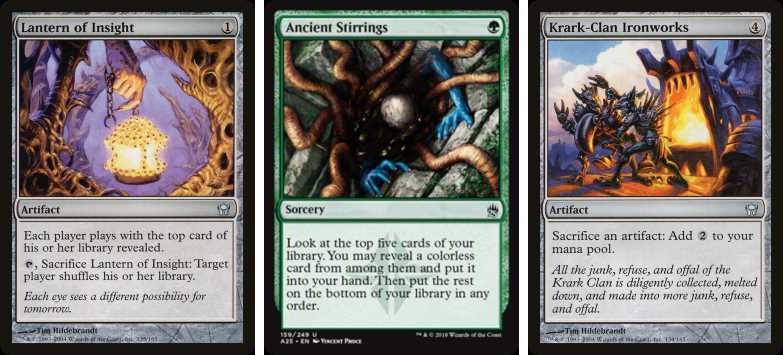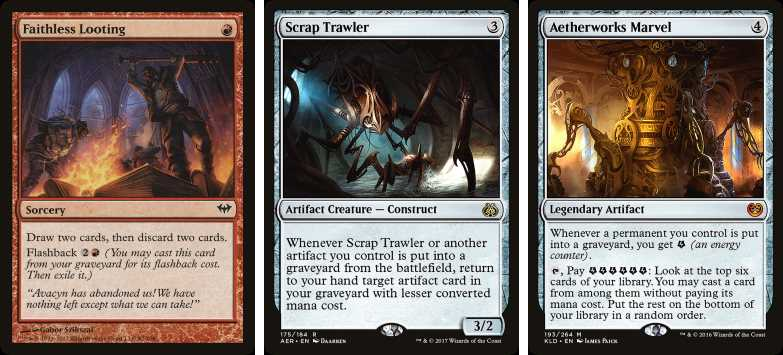Wizards of the Coast announced last week that the Banned & Restricted update had no changes to any formats. I feel this is correct as the formats are in a decent spot currently, and Modern in particular. With rotation around the corner, it feels silly to ban anything from Standard, despite the cries for Goblin Chainwhirler to leave the format. Legacy has garnered a second wind due to Gitaxian Probe and Deathrite Shaman exiting the format; the dust has yet to settle from that much-needed shake-up. I have a different issue with the recent Banned & Restricted updates, and I’ll explain more in this piece.
What I am disappointed in, and I feel Wizards of the Coast could do more of, is transparency. Unless Wizards have been living under a rock for the last few months, plenty of people have been calling for the banning of Ancient Stirrings as there is a consensus that Ironworks Combo is an issue. I disagree with both of these notions in part, and not just because I am a Tron pilot, but because I feel Ancient Stirrings isn’t the problem in these “artifacts matter” decks. Overall, I think that Ironworks Combo is currently acceptable and there is plenty of ways to deal with the deck. Whether people choose to figure it out is up to them.
Regardless, there’s a calling out for Ironworks Combo for the same problem that people took up with Lantern Control when it won Pro Tour Rivals of Ixalan, which is not everyone understands how the deck operates and therefore disregards the deck negatively with ease. Even back then, the calling for Ancient Stirrings to be banned was well versed in the Magic community for similar reasons. Decks such as Lantern Control and Ironworks Combo demand a certain skill level to pilot optimally, which can cause some disdain from the get-go. Coupling this with its long and perhaps tedious game-plan, Ironworks Combo generally becomes unpopular regardless of how powerful the deck is, and hits a niche amount of players. Don’t get me wrong, Ancient Stirrings is a powerful card, for sure; but I don’t think hitting Lantern Control, Tron, and the Eldrazi decks is worth it to slow down Ironworks Combo.

Metaphorically speaking if a card had to go in Ironworks Combo, however, the issue isn’t Ancient Stirrings—the issue is Scrap Trawler. Scrap Trawler is what made Ironworks Combo absurdly powerful and top tier: being able to obtain Mox Opals from the graveyard to fuel Pyrite Spellbomb is tremendously powerful and gives a far better win percentage than before. Besides, allowing Mox Opal to be a pseudo-Black Lotus is just absurd. Even in the pre-Kaladesh block, Ironworks Combo was an archetype, but seen as far looser and narrower in combination and relied a lot more on the Emrakul, the Aeon’s Torn kill instead. The deck was nowhere near as powerful compared to now, and I don’t think it’s a coincidence this changed since Scrap Trawler’s printing.
There is an argument for the namesake card, Krark-Clan Ironworks to take the hit instead; however, I don’t think Wizards are huge on outright killing decks unless it’s necessary. An example being Aetherworks Marvel in this case as it was incredibly dominant in Standard, whereas Modern warrants a larger card pool and there are more answers compared to Standard. I don’t think Krark-Clan Ironworks should be banned, but I can see why people take up issues with this card.
With future Banned and Restricted updates Wizards could do a fantastic job in responding to what the Magic community has been saying in regards to why a particular card should be banned, and why Wizards are for or against it. I feel it doesn’t need to be tremendously detailed nor do they need to buckle to peer pressure, but an overview or to make the “Watch List” more apparent to the community would go a long way. I believe if there were some transparency and method in how they go about these things more consistently would improve relations, and in some regards, calm down the outcries if some logic was in place from Wizards.
Going back to Aetherworks Marvel, I recall the announcement in June last year where Aetherworks Marvel was banned. There was a detailed article into why it was banned, what they tried, what failed and the options left. Even considering bringing back non-standard cards such as Pithing Needle into the mix in an attempt to fix the issue that Standard had become incredibly stagnant. Upon reading this announcement when it was first released, I found the whole process fascinating. It gave me a new appreciation for the Research & Development team and the factors they take into consideration, which you rarely hear about otherwise. Unfortunately, it seemingly only happens if a card becomes banned or unbanned, but otherwise, the announcements are short. The concept of a “Watch List” seems to have been abandoned and would love to see it make a return, and Wizards have access to a tremendous amount of data which they reluctantly share out to the community.
Either way, if I were to draft up a “Watch List” of some kind, the list would feature something from Ironworks Combo as it has the potential to become more powerful although I think it’s fine currently. Faithless Looting is another I would keep an eye on, given in these graveyard decks it’s mostly a draw three for one mana with flashback. Allowing such card advantage could be an issue, especially when the R/B Vengevine isn’t at its optimal build yet. However, I feel this is too early to pull the trigger on banning it.

Finally, I would have a watchful eye over Five-Color Humans. This may seem an irregular choice, but I feel the deck is getting to the point of being too consistent. Being able to run twelve lands that can cast a Human for any color (with no drawback) seems compelling in a vacuum. Being able to go from Noble Hierarch, into Kitesail Freebooter, into Mantis Rider feels like something that shouldn’t be able to exist in a deck given the mana demand in all five of the colors.
Furthermore, the creature type Human is the most popular creature subtype in all of Magic, meaning human cards will always be accessible, and what seems the average cards may be influential within this build. Consider Militia Bugler: on the surface it seems a relatively unexciting card, but within the Five-Color Humans build, Militia Bugler hits every creature besides Mantis Rider. Couple it with all the synergies the deck offers from Thalia’s Lieutenant and Champion of the Parish, Militia Bugler feels inherently powerful within this build. There could be a consideration that Wizards may need to either print fewer humans, which I don’t think will happen given how unpopular Lowryn was initially, or they have to hose the Modern deck at some point to allow more room for design. In my opinion, I wouldn’t be surprised to see the land base being hit by the ban at some point, like Ancient Ziggurat for example, or even Unclaimed Territory at worst. Ancient Ziggurat is the least impactful on Modern overall and only hits this Humans deck, so this seems the more sensible choice.
Regardless, with future Banned and Restricted updates, I feel the sentiment to become more transparent in their process would go far into understanding why the changes or no changes have been made. I imagine it’s not a simple step, and perhaps resources are already stretched but feel efforts such and these would give the community some logic to process, while not blindly calling out cards for the sake of doing so. A point could be made given the rough patch that Standard went through within the last year with the banning of Aetherworks Marvel, Smuggler’s Copter, and Rampaging Ferocidon (to name a few) was down to peer pressure from the community. I don’t think these instances are a coincidence, but it’s easy to assume that this was the case and maybe some habits stick, given how easy making your thoughts known through social media these days.
Nonetheless, banning cards should be the absolute final action and shouldn’t happen with ease. If this was the case, this generates a poor advertisement for the game and reduces consumer confidence which I feel is happening currently in the Standard format, but should be definitive if necessary. Mistakes do happen, and cards have the potential to become better or worse over time with more cards printed, so I think from a design perspective it’s not as clear-cut as it may initially seem.
Emma resides in Suffolk, England and started playing Magic back in 2014 when Khans of Tarkir first hit the shelves. She dabbled in Standard for a while then shifted into Modern, in particular playing Eldrazi Tron and Commander where she has found her home. Follow her on Twitter @emmmzyne to join in on the conversation!

